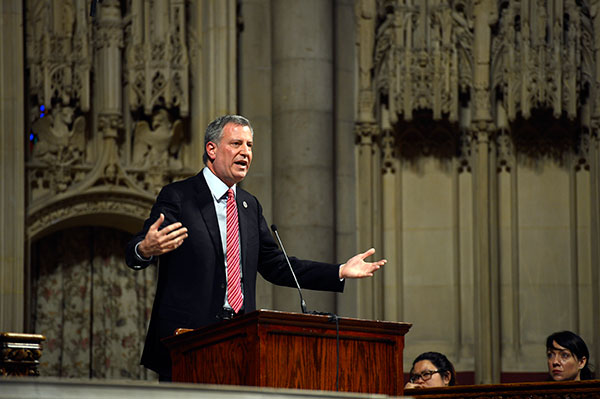
Mayor Bill de Blasio delivering an education speech (Rob Bennett/NYC Mayor's Office)
Focusing on programs that help at-risk college students achieve doesn't get them in the door, so the mayor must put more energy and funding into college access.
This time a year ago, New York City residents were knee-deep in sorting through the promising rhetoric offered by hopeful bureaucrats vying to become the next Mayor of New York City. "The Tale of Two Cities"– the signature campaign phrase that helped propel Bill de Blasio into becoming the next chief executive of America's largest city – speaks to the severity of the economic inequality that exists in New York City and across the country.
Mayor de Blasio's election was an overnight mandate for progressive reform, which greatly emphasized increasing resources for New York City's schools. This year's final New York City budget does take steps in the right direction by investing more in the City University of New York (CUNY) and programs like the Accelerated Study in Associate Programs and the Black Male Initiative to help the most at-risk students succeed while at college. These investments are necessary – especially given that 42 percent of CUNY community college students experience housing insecurity, 39 percent experience food insecurity, and 65 percent come from households with incomes less than $30,000 per year.
However, let's be clear: the mayor is not placing equal priority on college access, a choice that is dangerously shortsighted and will be much more costly in the end. The programs and opportunities that at-risk New York City high school students have available to help them access college are just as important as the programs that help students after admission.
While most New York City high school students know that a high school diploma is no longer good enough, and acknowledge the need for a college degree, almost 70 percent of students believe that a high school diploma alone would adequately prepare them for college-level coursework. Yet only 25 percent of students are graduating college-ready in New York City. Just 29 percent of high school graduates in the class of 2012 had test scores high enough to avoid remedial courses at the city's public schools. What's worse is that 74 percent of first-time freshmen entering CUNY community colleges needed remedial coursework in math, up 15 percent from 2002. Nearly three out of four high school students are either failing to graduate on time or lack the basic academic skills needed to hit the ground running at CUNY.
It is clear that the City should be doing more to help members of the most at-risk communities access college while simultaneously injecting the CUNY system with enough resources to effectively meet the demand.
There's no debate: public higher education, while not perfect, is a proven and successful model to help prepare young people socially and economically to become life-long contributing citizens. However, the critical four-year path leading a young person toward college can make or break a student's college attainment. The mayor should seize the opportunity and lead the people of New York and the nation's cities to address this issue head on by jump-starting an inclusive public policy process that will lay out an aggressive plan for other cities across America to follow.
In addition to the obvious players like the NYC Department of Education, New York State Education Department, and CUNY, the mayor must bring to the policy table local stakeholders like the College Access Consortium of New York and groups like the Goddard Riverside Community Center, as well as national models such as College Track and partners like the Lumina Foundation to put New York City on a collaborative path to increasing college attainment and by doing so, tackling economic inequality.
To start, initial conversations should include how to best leverage existing government infrastructure and systems to think collaboratively and across agencies about policy solutions. For example, we could analyze programs offered by the New York City Department of Housing to integrate effective and proven programs in public housing facilities. The issue of college access is an intersectional problem and requires intersectional solutions. This issue requires Mayor de Blasio to employ a policy process that is inclusive, grounded in research and analysis, utilizes all the resources we have available, and injects even more resources to change this much talked about but greatly under-addressed issue of college access or the lack thereof.
***
Kevin Stump is Campus Network Leadership Director at the Roosevelt Institute
A version of this article was originally posted at Next New Deal, the blog of the Roosevelt Institute
***
Do you have an op-ed idea or submission for Gotham Gazette? Send it to Executive Editor Ben Max: This email address is being protected from spambots. You need JavaScript enabled to view it.